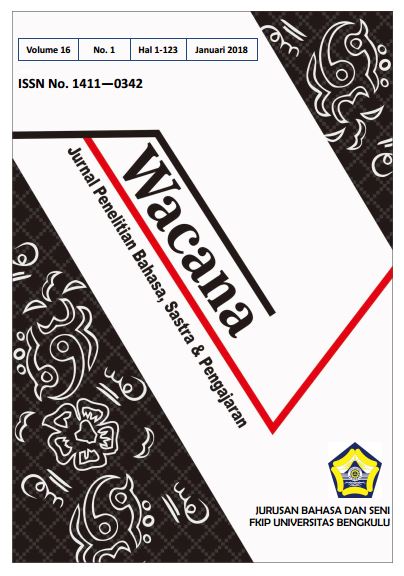Main Article Content
Abstract
This preliminary study is intended to describe the distribution of languages of ethnic groups in Bengkulu Province. This research is based on geographic linguistics in the province of Bengkulu. The basic vocabulary instrument is 300 (Swadesh and Kern) and 150 cultural vocabularies. Data collection is carried out at a number of observed villlages proportionally. Data analysis was performed with lexicostatistics and dialectometry. The results show the following. With the exception of Enggano and the languages of ethnic immigrants, the Rejang, Lembak, Serawai, Pasemah, and Mukomuko languages are related to each other. The differences between these ethnic languages are mostly at the level of vowel sounds /a/, /o/ or /aw /, /é/ and /ê/, diphthong, nasal clusters such as /mp/, /nt/, /nc/, and /ngk/ on the one hand and /p/, /t/, /c/, /k/ on the other. Rejang language has 4 dialects, that are Lebong, Musi, Keban Agung and Pesisir. The distribution of Rejang ethnic languages covers Lebong District, part of Rejang Lebong, parts of Kepahiang, parts of Bengkulu Utara, and parts of Bengkulu Tengah Regency, while Mukomuko ethnic language distribution covers some areas of Mukomuko Regency. The spread of Lembak language covers Padang Ulak Tanding and Padang sub-districts in Rejang Lebong, and in some villages in Bengkulu and Bengkulu Tengah Regency. Serawai language has distribution in of Seluma and Bengkulu Selatan Regencies, in addition to some villages in Kepahiang Regency. Pasemah ethnic language has distribution in some areas of Kabupaten Kaur. The Lembak, Serawai, and Pasemah languages are used in the written tradition of the Ulu script. Some specimens of Ulu Lembak, Serawai, and Pasemah texts are preserved as family heirlooms or village heirlooms in the area of the ethnic language in question.
Keywords: linguistics geography, ethnic language, Bengkulu
Article Details
Authors who publish in this journal agree with the following terms:
- Authors retain copyright and grant the journal right of first publication with the work simultaneously licensed under a Creative Commons Attribution License that allows others to share the work with an acknowledgement of the work's authorship and initial publication in this journal.
- Authors are able to enter into separate, additional contractual arrangements for the non-exclusive distribution of the journal's published version of the work (e.g., post it to an institutional repository or publish it in a book), with an acknowledgement of its initial publication in this journal.
- Authors are permitted and encouraged to post their work online (e.g., in institutional repositories or on their website) prior to and during the submission process, as it can lead to productive exchanges, as well as earlier and greater citation of published work (See The Effect of Open Access).
- This work is licensed under a Creative Commons Attribution-ShareAlike 4.0 International License.
